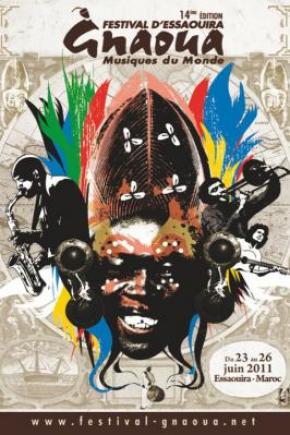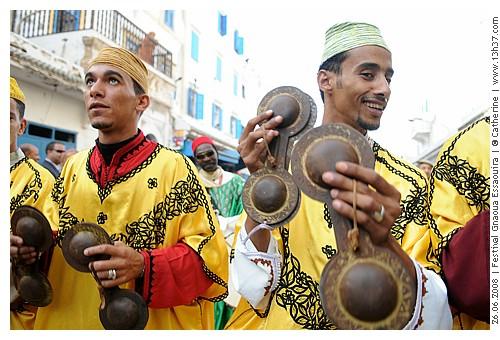The Visible And The Invisible. The 14th Festival of Essaouira Gnaoua et Musiques du Monde
For four days last month, tens of thousands of fans from around the world descended on Essaouira, Morocco, for an African musical extravaganza: the annual festival Gnaoua et Musiques du Monde, now in its 14th edition. The protagonist of this musical feast was as usual Gnawa music: when to Gnawa masters like Mustapha Baqbou, Mohammed Guinea, and Hassan Boussou were not on the main public stages, they were performing lilas (night of healing) that began at midnight at different riads (traditional style Moorish house with a courtyard); and that is where true European aficionados went to trance and to learn the specifics of daqa marrakchiya (the percussive clap associated with the city of Marrakesh). But the rhythms and colors of the Gnawa were providing the sonic backdrop for other kinds of music – Sufi brotherhoods like the Issawa, and musical genres from across Africa and the African diaspora. Beyond these African lines, this 2011 edition saw Indian tabla master Trilok Gurtu, Armenian pianist Tigran, and the fusion experimentation of Maâlem Hamid El Kasri with Between Worlds (an Afghan/Iranian duo featuring harmonium player Humayun Khan, and singer/guitarist Shahin Shahida).
 photo by Will Jenkins
photo by Will Jenkins
As in previous editions, the various elements of Rock, Jazz, Reggae, or Hip Hop, are easily integrated into the Gnawa style. Since 1998, the festival of Essaouira – one of the most popular in Morocco – has proved to be a unique experience in musical fusion, a gathering of international artists from various parts of Africa and the world, to jam along with the local and national Gnawa masters. The continued emphasis on both tradition and fusion has been one of the core values of the festival, allowing the magic of improvisation – a central element in Gnawa music itself – to operate and mingle along with a variety of other musical elements. Besides the vivid musical tradition exhibited during the acoustic lilas concerts, fusion on the main stages is in fact highly encouraged and an essential part of the festival’s identity since its beginnings.
This is not your usual music festival: days before the festival begins, musicians from all over the world meet with the Gnawa masters to rehearse and experiment new musical directions that will be developed during the live shows. These “artistic residencies” are highly valued and, according to the organizers they are “The heart of the festival”. As the festival name itself significantly suggests – Gnaoua et Musiques du Monde –, there is indeed a selective affinity with fusion, the Gnawa masters moving quite naturally in and out of the Gnawa tradition. With its various stages spread across the city and its World music aficionados, the festival joyfully displays the values of tolerance and diversity, an openness towards the Other that naturally derives from the experimentations in fusion.
 In a discussion after his press conference, the Malian vocalist Salif Keita explained that music can bridge North Africa and sub-Saharan Africa in a way that politics cannot – “Music can do what politics cannot.” And from the opening night, sub-Saharan artists were on display, when Baba Sissoko and the Mali Tamani Revolution shared the stage with Maâlem Benseloum Kbiber. On Saturday night, K’naan, the Somali hip hop artist, was followed on stage by Maâlem Mahmoud Guinea, a living legend of Gnawa music. But the festival also tries to cross the Atlantic and connect North Africa with the African diaspora communities of the New World. The band Jazz-Racines Haïti was prominently showcased, and spoke about their blood ties to the Gnawa.
In a discussion after his press conference, the Malian vocalist Salif Keita explained that music can bridge North Africa and sub-Saharan Africa in a way that politics cannot – “Music can do what politics cannot.” And from the opening night, sub-Saharan artists were on display, when Baba Sissoko and the Mali Tamani Revolution shared the stage with Maâlem Benseloum Kbiber. On Saturday night, K’naan, the Somali hip hop artist, was followed on stage by Maâlem Mahmoud Guinea, a living legend of Gnawa music. But the festival also tries to cross the Atlantic and connect North Africa with the African diaspora communities of the New World. The band Jazz-Racines Haïti was prominently showcased, and spoke about their blood ties to the Gnawa.
For fourteen years the Essaouira festival Gnaoua et Musiques du Monde has provided an opportunity for youth across Morocco – lovers of African music – to see their favorite local and international artists perform; but this annual musical pilgrimage also provides a time for all these young fans to meet and exchange ideas. During the midday heat – hours before the concerts begin – young aspiring Gnawa and Reggae artists gather in the shade of the medina’s remparts – a vestige of Castelo Real de Mogador’s 16th century Portuguese presence. Reggae groups like Bih Fih from Sefrou and Mektoub from Kenitra will informally display their talent.
Every day at this year’s festival – morning or afternoon – aficionados had the opportunity to listen to artists talk about their art at the Alliance Franco-Marocaine’s “Arbre à palabres” conversations. One act that intrigued festival-goers and caused much discussion at the Alliance Franco-Marocaine was Bnat Gnaoua: Morocco’s first female Gnawa group. The “Arbre à palabres” conversations provided also an invaluable opportunity to discuss, within Gnawa culture, the-always-hard-to-avoid-questions of tradition and/or modernity. Most Gnawa masters holding improvisation within tradition itself for one of the essential parts of their music, the experimental fusions with other musical genres is just another step that they will embrace without difficulties. The intimate and acoustic lilas concerts prove that the Gnawa tradition remains a lively one. Yet, as it enters the amplified stages, Gnawa music easily connects with fusion and other Musiques du Monde, also suggesting that the Gnawa tradition is in fact a flexible one. There certainly was consensus, during the “Arbre à palabres” conversations, about the idea that contemporary Gnawa culture allows for “equilibrium between tradition and modernity”. As musical critic and moderator for the “Arbre à palabres” Emmanuelle Honorin interestingly put it: “The visible” (i.e. the public festival, the amplified stage, the fusion) “protects the invisible” (i.e. the private ritual, the healing ceremony, the spiritual dimension). In other words, renovation and exposure are what keep Gnawa culture alive. This may be one of the most insightful lessons of Gnawa music as it was exhibited, discussed and performed, during this year’s festival.
 photo by Catherine
photo by Catherine
It has been long since the Festival of Essaouira was dubbed “the Moroccan Woodstock”. In recent years Morocco has witnessed a tremendous music festival boom in various cities such as Marrakesh, Fez, Agadir, or Casablanca. Yet many Moroccans and foreign aficionados still cherish Essaouira as a special and unique place. There is no doubt that Bob Marley’s visit to Essaouira in the 1980s, or Jimi Hendrix’s in the 1960s – long before the festival existed –, provided the place with a quasi-mythical aura. Their spiritual legacies live on and contribute, along with the Gnawa mystique, to the magic of Essaouira as a place that is both real and imagined.
The Essaouira festival was a success again. On Wednesday and Thursday, before the festival began, a powerful wind blew from the Sahara, but the voices of Maâlem Guinea, Salif Keita and K’naan calmed even these winds – which also succumbed to the sounds and spirit of the Gnawa heritage.
Barcelona, July 22nd, 2011.